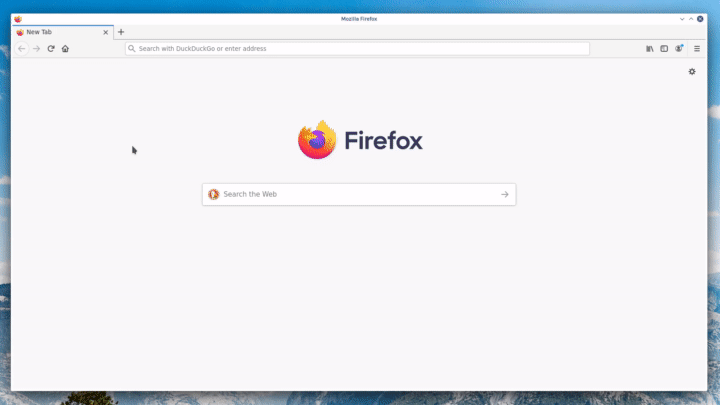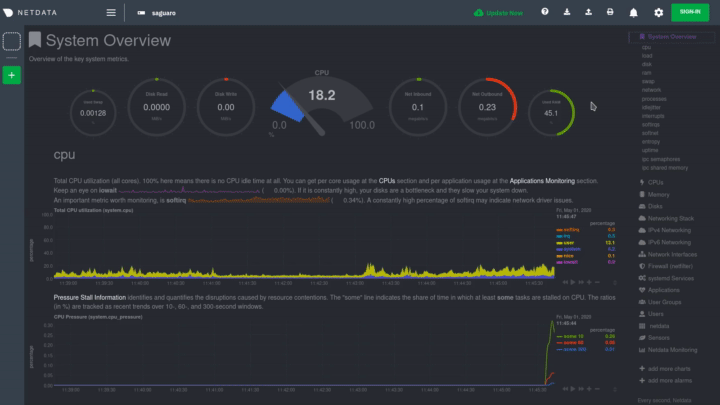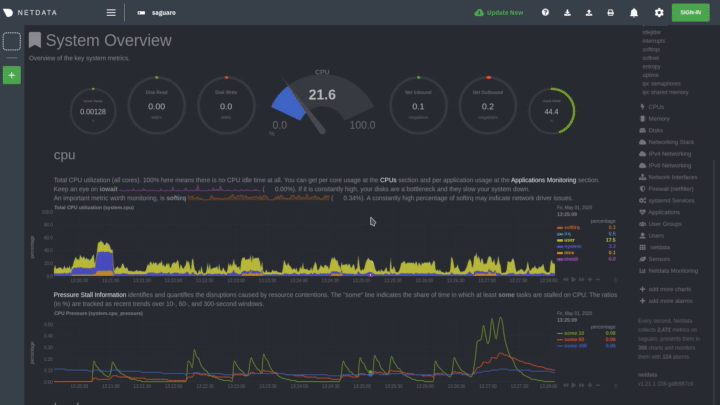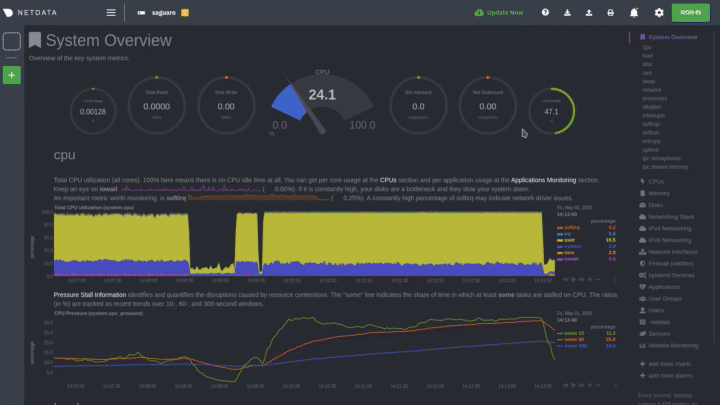mirror of
https://github.com/netdata/netdata.git
synced 2025-05-06 10:10:11 +00:00
minor fix, convert metadata of the learn to hidden sections Signed-off-by: Tasos Katsoulas <tasos@netdata.cloud>
118 lines
7.4 KiB
Text
118 lines
7.4 KiB
Text
<!--
|
|
title: "How the dashboard works"
|
|
description: >-
|
|
"Learn how to navigate Netdata's preconfigured dashboard to get started
|
|
exploring, visualizing, and troubleshooting in real time."
|
|
type: "explanation"
|
|
custom_edit_url: "https://github.com/netdata/netdata/blob/master/docs/dashboard/how-dashboard-works.mdx"
|
|
sidebar_label: "How the dashboard works"
|
|
learn_status: "Published"
|
|
learn_topic_type: "Concepts"
|
|
learn_rel_path: "Concepts"
|
|
-->
|
|
|
|
# How the dashboard works
|
|
|
|
Because Netdata is a monitoring and _troubleshooting_ platform, a dashboard with real-time, meaningful, and
|
|
context-aware charts is essential.
|
|
|
|
As soon as you [install Netdata](https://github.com/netdata/netdata/blob/master/docs/get-started.mdx), it autodetects hardware, OS, containers, services, and
|
|
applications running on your node and builds a dashboard on a single, scrollable webpage. This page features hundreds of
|
|
charts, which are preconfigured to save you time from learning a query language, all stacked on top of one another. This
|
|
vertical rhythm is designed to encourage exploration and help you visually identify connections between the metrics
|
|
visualized in different charts.
|
|
|
|
It's essential to understand the core concepts and features of Netdata's dashboard if you want to maximize your Netdata
|
|
experience right after installation.
|
|
|
|
## Open the dashboard
|
|
|
|
Access Netdata's dashboard by navigating to `http://NODE:19999` in your browser, replacing `NODE` with either
|
|
`localhost` or the hostname/IP address of a remote node.
|
|
|
|

|
|
|
|
Many features of the internal web server that serves the dashboard are [configurable](https://github.com/netdata/netdata/blob/master/web/server/README.md), including
|
|
the listen port, enforced TLS, and even disabling the dashboard altogether.
|
|
|
|
## Sections and menus
|
|
|
|
As mentioned in the introduction, Netdata automatically organizes all the metrics it collects from your node, and places
|
|
them into **sections** of closely related charts.
|
|
|
|
The first section on any dashboard is the **System Overview**, followed by **CPUs**, **Memory**, and so on.
|
|
|
|
These sections populate the **menu**, which is on the right-hand side of the dashboard. Instead of manually scrolling up
|
|
and down to explore the dashboard, it's generally faster to click on the relevant menu item to jump to that position on
|
|
the dashboard.
|
|
|
|
Many menu items also contain a **submenu**, with links to additional categories. For example, the **Disks** section is often separated into multiple groups based on the number of disk drives/partitions on your node, which are also known as a family.
|
|
|
|

|
|
|
|
## Charts
|
|
|
|
Every **chart** in the Netdata dashboard is [fully interactive](https://github.com/netdata/netdata/blob/master/docs/dashboard/interact-charts.mdx). Netdata
|
|
synchronizes your interactions to help you understand exactly how a node behaved in any timeframe, whether that's
|
|
seconds or days.
|
|
|
|
A chart is an individual, interactive, always-updating graphic displaying one or more collected/calculated metrics,
|
|
which are generated by [collectors](https://github.com/netdata/netdata/blob/master/docs/collect/how-collectors-work.md).
|
|
|
|

|
|
|
|
Hover over any chart to temporarily pause it and see the exact metrics values presented as different dimensions. Click
|
|
or tap to stop the chart from automatically updating with new metrics, thereby locking it to a single timeframe.
|
|
Double-click it to resume auto-updating.
|
|
|
|
Let's cover two of the most important ways to interact with charts: panning through time and zooming.
|
|
|
|
To pan through time, **click and hold** (or touch and hold) on any chart, then **drag your mouse** (or finger) to the
|
|
left or right. Drag to the right to pan backward through time, or drag to the left to pan forward in time. Think of it
|
|
like pushing the current timeframe off the screen to see what came before or after.
|
|
|
|
To zoom, press and hold `Shift`, then use your mouse's scroll wheel, or a two-finger pinch if you're using a touchpad.
|
|
|
|
See [interact with charts](https://github.com/netdata/netdata/blob/master/docs/dashboard/interact-charts.mdx) for all the possible ways to interact with the charts on
|
|
your dashboard.
|
|
|
|
## Alarms
|
|
|
|
Many of the preconfigured charts on the Netdata dashboard also come with preconfigured alarms. Netdata sends three
|
|
primary alarm states via alarms: `CLEAR`, `WARNING`, and `CRITICAL`. If an alarm moves from a `CLEAR` state to either
|
|
`WARNING` or `CRITICAL`, Netdata creates a notification to let you know exactly what's going on. There are [other alarm
|
|
states](https://github.com/netdata/netdata/blob/master/health/REFERENCE.md#alarm-statuses) as well.
|
|
|
|
The easiest way to see alarms is by clicking on the alarm icon 
|
|
in the top panel to open the alarms panel, which shows you all the active alarms. The other **All** tab shows every
|
|
active alarm, and the **Log** tab shows a historical record of exactly when alarms triggered and to which state.
|
|
|
|

|
|
|
|
Learn more about [viewing active alarms](https://github.com/netdata/netdata/blob/master/docs/monitor/view-active-alarms.md), [configuring
|
|
alarms](https://github.com/netdata/netdata/blob/master/docs/monitor/configure-alarms.md), or [enabling a new notification
|
|
method](https://github.com/netdata/netdata/blob/master/docs/monitor/enable-notifications.md).
|
|
|
|
## What's next?
|
|
|
|
Learn more about [interacting with charts](https://github.com/netdata/netdata/blob/master/docs/dashboard/interact-charts.mdx) to quickly pan through time, zoom, and
|
|
show/hide dimensions to best understand the state of your node in any timeframe. A complete understanding of [chart
|
|
dimensions, contexts, and families](https://github.com/netdata/netdata/blob/master/docs/dashboard/dimensions-contexts-families.mdx) will also help with how Netdata
|
|
organizes its dashboard and operates [alarms](https://github.com/netdata/netdata/blob/master/docs/monitor/configure-alarms.md).
|
|
|
|
### Further reading & related information
|
|
|
|
- Dashboard
|
|
- **[How the dashboard works](https://github.com/netdata/netdata/blob/master/docs/dashboard/how-dashboard-works.mdx)**
|
|
- [Interact with charts](https://github.com/netdata/netdata/blob/master/docs/dashboard/interact-charts.mdx)
|
|
- [Chart dimensions, contexts, and families](https://github.com/netdata/netdata/blob/master/docs/dashboard/dimensions-contexts-families.mdx)
|
|
- [Select timeframes to visualize](https://github.com/netdata/netdata/blob/master/docs/dashboard/visualization-date-and-time-controls.mdx)
|
|
- [Import, export, and print a snapshot](https://github.com/netdata/netdata/blob/master/docs/dashboard/import-export-print-snapshot.mdx)
|
|
- [Customize the standard dashboard](https://github.com/netdata/netdata/blob/master/docs/dashboard/customize.mdx)
|
|
- [HTTP API](https://github.com/netdata/netdata/blob/master/web/api/README.md)
|
|
- [Custom dashboards](https://github.com/netdata/netdata/blob/master/web/gui/custom/README.md)
|